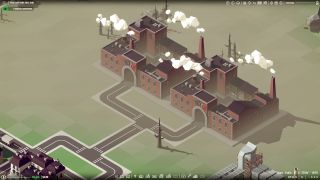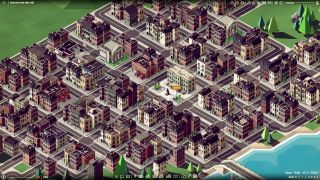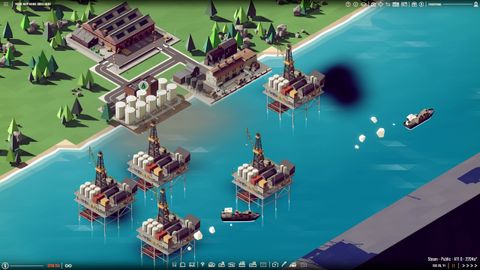Our Verdict
Beautiful style, polished interactions, but ultimately it just runs out of things to do.
PC Gamer's got your back
What is it? A minimalist factory builder.
Expect to pay £23/$30
Developer Dapper Penguin
Publisher Kasedo Games
Reviewed on Intel i5, 16gb RAM, Nvidia GTX 970
Multiplayer No
Link Official site
The first thing you’ll notice upon playing Rise of Industry is that it’s absolutely gorgeous. The boxy shapes and flat colours of the low-poly style are a perfect fit for the city/factory builder genre. This, combined with bright colours and sticker-like icons, makes the game looks less like a real city and more like a child’s play set. Unfortunately that’s also how the game plays: it's a fun toy, but it could use a little more direction.
Rise of Industry is fundamentally about supply and demand. There are a handful of towns of various sizes spread across the map, each of which has two to four stores which will buy a certain good. Your job is to fulfil that demand. This can be as simple as mining some coal and shipping it directly to the hardware store, or as complicated as the pizza, a fiendish puzzle of a product that requires mills producing flour, vegetable farms and a dairy producing cheese (itself a multistep product requiring both cows and the wheat to feed them).
A great deal of thought has gone into refining all of these interactions, buildings thunk down satisfyingly, trucks chug along adorably and even the menu buttons click pleasingly. Clearly a lot of effort has been put into ensuring that the game feels fundamentally pleasing to play.

All this is remarkably easy to pick up as well. Earlier I said the game looks gorgeous, and this extends to a simple but elegant UI. I was particularly a fan of the little bubbles that pop up to show what product a building is producing and how far along it is. This, along with other icons make it easy to diagnose problems like disconnected roads or too many products in storage.
In addition to this helpful UI, the game pushes you toward useful outside sources of information, with links to both the wiki and a helpful YouTube tutorial right there on the start menu. I must admit this last addition left me with an interesting decision as to whether these external tools should be considered part of the game for the review, but eventually I decided they should. Let’s face it, this is how most of us learn how to play complex games nowadays. Dapper Penguin has simply made it part of the experience.

Eventually things get a little bit more complicated, with the player getting access to heavier trucks, trains, boats and even zeppelins to haul products and set up long distance supply chains across the map. The only problem here is I didn’t feel enormous pressure to use them. You see, resources are spread so evenly across the map it seems just as easy to build a new manufacturing facility near your destination as it is to set up a railway line.
Perhaps someone better at capitalism than me can point out how much I’d be shaving off my margins delivering my mutton by zeppelin, but at the moment I’m mostly doing it because mutton zeppelins are cool, not because I think they’re helping. Perhaps if all the iron ore on the map was clustered in one corner and all the trees in another a cross country train line would make sense, but this is rarely the case.
How much you’ll enjoy Rise of Industry is largely going to depend on how capable you are of making your own fun
It doesn’t help that the “campaign” is what I would usually consider a sandbox mode, while the actual “sandbox” is just the same thing but with infinite money and everything unlocked. There are AI competitors, but they don’t seem to add much beyond being a nuisance when they buy exclusive rights to build in an area I was targeting. There’s no real ability to undercut your competition by offering a cheaper product or better marketing, instead the different corporations mostly stay out of each other’s way so that everyone can keep making money, in exactly the way capitalism isn’t supposed to work, but does.
How much you’ll enjoy Rise of Industry is largely going to depend on how capable you are of making your own fun. The fundamental interactions are very strong, but the only goal the developers offer is creating an endgame product (a car, a computer or a ready meal). There’s no real capacity for expression and creativity either, one supply chain looks much like another, and the player is chasing efficiency, not aesthetics. I got a good few hours of fun out of Rise of Industry, but ultimately once that time had passed I found I simply wasn’t interested in creating a slightly more profitable brick factory than my last one, perhaps I’m simply not enough of a capitalist.
Beautiful style, polished interactions, but ultimately it just runs out of things to do.

